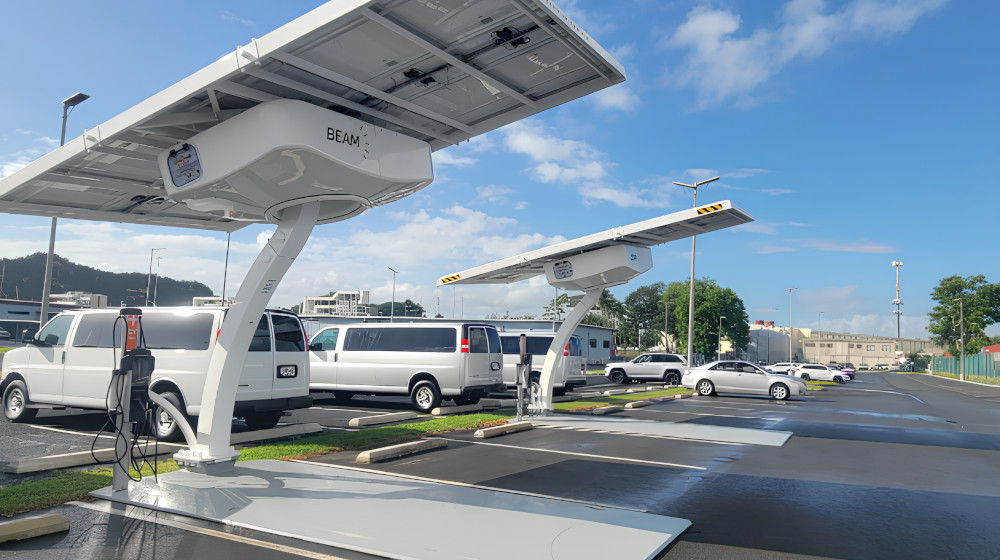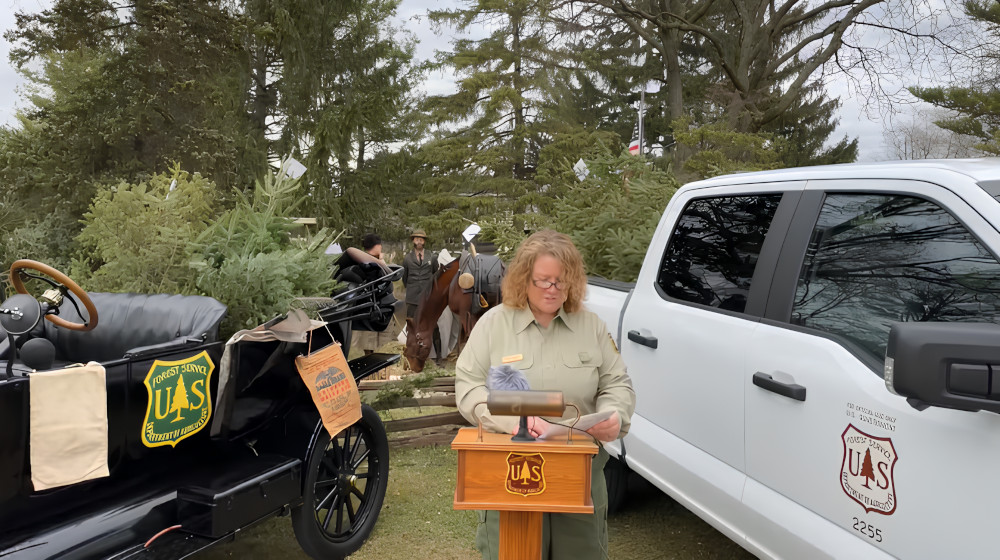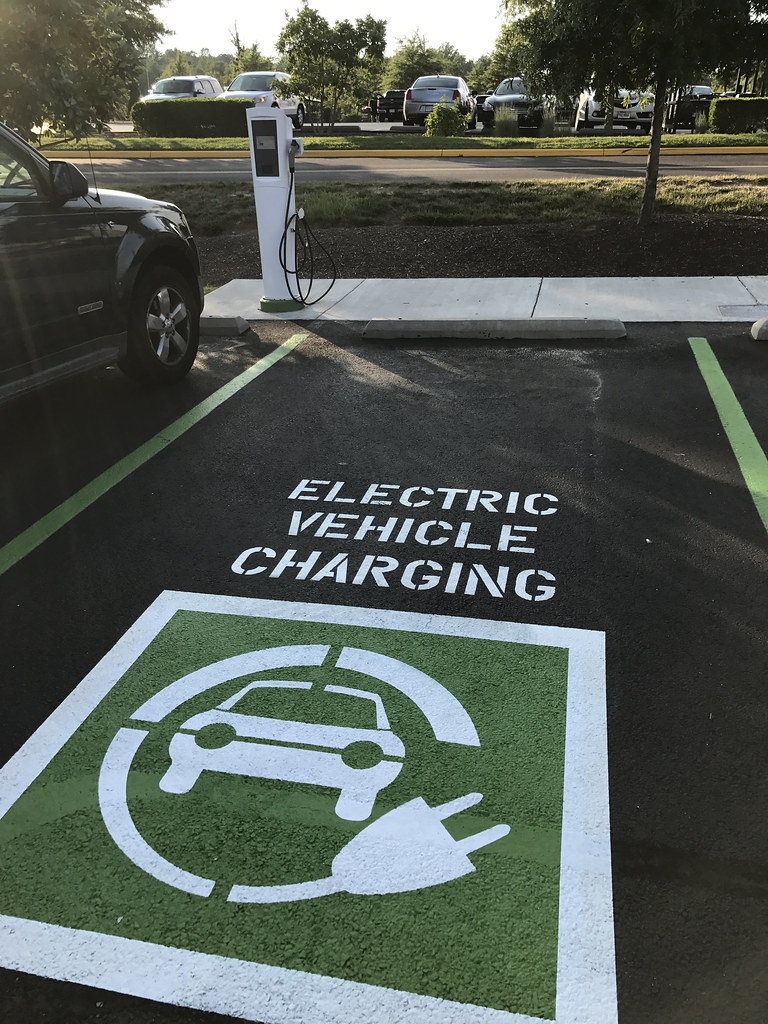Electric Vehicles and Electric Vehicle Supply Equipment
The transportation sector generates the largest share of emissions in the U.S. accounting for 28 percent of all emissions![]() or roughly 6,340 Million Metric Tons of CO2 equivalent. Transitioning the federal fleet from combustion engine vehicles to electric is a primary pillar of the federal government's effort to decarbonize the transportation sector and reduce emissions. By reducing vehicle emissions, the U.S. General Services Administration (GSA) will help improve the health of our citizens and the future of our planet.
or roughly 6,340 Million Metric Tons of CO2 equivalent. Transitioning the federal fleet from combustion engine vehicles to electric is a primary pillar of the federal government's effort to decarbonize the transportation sector and reduce emissions. By reducing vehicle emissions, the U.S. General Services Administration (GSA) will help improve the health of our citizens and the future of our planet.
The federal non-tactical fleet, which carries out a variety of essential agency missions, from food inspection and nuclear waste cleanup to forest and land management, is approximately 656,000 vehicles and drove 4.3 billion miles in 2022 on 379 million gallons of fuel. This equates to 3.4 million metric tons of Greenhouse Gas (GHG) emissions -- equivalent to the energy use in 424,503 homes for one year or 3.78 billion pounds of coal burned. Important components of this effort include reducing the federal fleet’s footprint by transitioning to electric vehicles (EVs) and other zero emission vehicles (ZEVs), as well as encouraging additional footprint reductions among commuting federal employees.
Getting started on deploying Electric Vehicle Supply Equipment (EVSE) (also known as electric vehicle charging infrastructure) can seem daunting, with many decisions to make. The U.S. General Services Administration and its federal partners support federal agencies and other eligible entities![]() in their efforts to transition to an all-electric vehicle fleet and provide the tools and resources needed to enable streamlined procurement, installation, and maintenance of EVSE. The solutions and resources available aim to alleviate confusion, reduce redundancies, simplify decision making, and help fleet, building, and energy managers select an appropriate course of action. All efforts to deploy EVSE should begin with gathering information, then assessing your site specific needs, and selecting an appropriate plan of action. Plans of action will differ simply because every site is different, utility incentives differ and every site has a different vehicle makeup from quantity of vehicles to vehicle battery sizes to vehicle utilizations. Different contract vehicles may support the project and can be dependent on existing agency resources, authorities and appropriations.
in their efforts to transition to an all-electric vehicle fleet and provide the tools and resources needed to enable streamlined procurement, installation, and maintenance of EVSE. The solutions and resources available aim to alleviate confusion, reduce redundancies, simplify decision making, and help fleet, building, and energy managers select an appropriate course of action. All efforts to deploy EVSE should begin with gathering information, then assessing your site specific needs, and selecting an appropriate plan of action. Plans of action will differ simply because every site is different, utility incentives differ and every site has a different vehicle makeup from quantity of vehicles to vehicle battery sizes to vehicle utilizations. Different contract vehicles may support the project and can be dependent on existing agency resources, authorities and appropriations.
The information in this module is intended for any institution seeking to install, manage, operate or maintain electric vehicles and EVSE.
Federal Requirements
Federal fleet requirements![]() and agency policy guide, direct and encourage federal fleet electrification efforts. To help meet these mandates, GSA is leading by example and proactively working to provide resources, tools, and access to the products and services that its partners seek to support its customer agencies and make the federal fleet electrification initiative a success.
and agency policy guide, direct and encourage federal fleet electrification efforts. To help meet these mandates, GSA is leading by example and proactively working to provide resources, tools, and access to the products and services that its partners seek to support its customer agencies and make the federal fleet electrification initiative a success.
Electric Vehicles and Electric Vehicle Supply Equipment Components
- Parking Garage - Internal Space
- Parking Garage- External Space
Acquiring EVs and EVSE
The following resources are available to federal customers to streamline the EV and EVSE acquisition and installation processes:
- Acquiring EVs: Per to FPMR 101-26.501, GSA is the mandatory source for federal agencies to purchase any new non-tactical vehicles including EVs. Other eligible users
 can also purchase vehicles from GSA. Agencies can purchase
can also purchase vehicles from GSA. Agencies can purchase or lease
or lease from GSA.
from GSA. - GSA Multiple Award Schedule BPAs: GSA has awarded 16 Blanket Purchase Agreements (BPAs)
 (9 are small business) with over 30 EVSE brands and 1,165 line items. Product and service offerings include Hardware, Software, Site Assessments, Consulting, Managed Charging, Charging as a Service (Caas) Warranty and others. For more information, please visit gsa.com/electrifythefleet
(9 are small business) with over 30 EVSE brands and 1,165 line items. Product and service offerings include Hardware, Software, Site Assessments, Consulting, Managed Charging, Charging as a Service (Caas) Warranty and others. For more information, please visit gsa.com/electrifythefleet or check out Multiple Award Schedule EVSE Offerings on category 3361E.
or check out Multiple Award Schedule EVSE Offerings on category 3361E.
- GSA Installation and Infrastructure IDIQs: GSA offers a Governmentwide Design/Build & Construction Electric Vehicle Supply Equipment (EVSE) IDIQ contract to purchase from the Federal Supply Schedule (FSS) EVSE and Ancillary Services Blanket Purchase Agreements (BPAs). For more information, please visit Governmentwide Design/Build and Construction IDIQ Contracts for EVSE Installation and Related Infrastructure
 .
. - For resources and comprehensive information about GSA’s EVSE products and services, please visit: GSA's "One-Stop Shop" for Fleet Electrification

- For additional guidance on cost-effective and sustainable acquisition, access SFTool’s Buyer Resources module
 .
.
Planning for EV and EVSE
There are many factors to consider when planning to acquire, install, and maintain EV and EVSE. The Federal Fleet ZEV Readiness Center![]() provides step-by-step guidance on how to successfully electrify the fleets. The Department of Energy
provides step-by-step guidance on how to successfully electrify the fleets. The Department of Energy![]() and GSA
and GSA![]() also provide additional training.
also provide additional training.
Here are considerations and resources to ensure a well-informed project at every phase:
Lessons Learned
- Plan for change
EV and EVSE technology is novel and constantly evolving. Prepare for evolving guidance, mandates, and emerging technologies. Automakers provide publicly available operational videos and GSA and DOE maintain up to date training and offer in person and virtual training such as FedFleet , the Energy Exchange
, the Energy Exchange and the EVSE Showcase
and the EVSE Showcase . Consider setting aside a portion of your budget to account for a shifting EV and EVSE landscape, including increased technology costs, installation costs, cultural change training and possible increased labor costs with the integration of subject matter experts and consultants into your project team.
. Consider setting aside a portion of your budget to account for a shifting EV and EVSE landscape, including increased technology costs, installation costs, cultural change training and possible increased labor costs with the integration of subject matter experts and consultants into your project team. - No one size fits all approach
Each EV fleet and EVSE installation project is different and requires thorough project plan and project scoping. There is no one approach that will work for every project- be sure to understand your current EV and EVSE capabilities in every capacity, from your project team’s bandwidth to your existing site infrastructure. - Senior level buy-in
Securing senior level buy-in is essential for a successful EV and/or EVSE project. Constructing a solid project plan with clearly defined milestones and can help you secure the financial and logistical support you need from senior management. Use the Case Studies below and these Fleet Electrification Success Stories to help you build a case for your project.
to help you build a case for your project. - Senior level buy-in
Securing senior level buy-in is essential for a successful EV and/or EVSE project. Constructing a solid project plan with clearly defined milestones and can help you secure the financial and logistical support you need from senior management. Use the Case Studies below and these Fleet Electrification Success Stories to help you build a case for your project.
to help you build a case for your project. - Plan for charging
Plan for charging before acquiring EVs. Find public or government-owned chargers using the Department of Energy Alternative Fueling Station Locator , which allows you to search by ownership type – the desktop version allows users to download specific station information. You can also search on a particular charging providers' sites (such as Tesla, ChargePoint, Blink, Electrify America, etc.) or on larger platforms that allow users to search across multiple providers, such as Plugshare
, which allows you to search by ownership type – the desktop version allows users to download specific station information. You can also search on a particular charging providers' sites (such as Tesla, ChargePoint, Blink, Electrify America, etc.) or on larger platforms that allow users to search across multiple providers, such as Plugshare or EVHype
or EVHype . If looking to install stations on-site, work with your local utility early and often.
. If looking to install stations on-site, work with your local utility early and often.
Case Studies

Army Corps of Engineers - Solar Install , Galveston, TX
, Galveston, TX
The Army Corps of Engineers in Galveston, TX received a level 2 solar station![]() . This station is not tied to the grid and took just 4-1/2 hours to set up before it was ready to charge vehicles. According to the technician, this setup will withstand winds up to 150 mph. The motor driven platform above the parking area tracks the sun's movement for continuous charging, ensuring the station always has adequate battery power.
. This station is not tied to the grid and took just 4-1/2 hours to set up before it was ready to charge vehicles. According to the technician, this setup will withstand winds up to 150 mph. The motor driven platform above the parking area tracks the sun's movement for continuous charging, ensuring the station always has adequate battery power.

U.S. Forest Service F-150 Pilot Program , Dearborn, MI
, Dearborn, MI
In December, 2022 the Forest Service announced a pilot program![]() for F-150 Lightning trucks at its field site in Dearborn, MI. This pilot program creates a great opportunity to see how the new electric trucks handle rugged and remote missions and understand the viability of wide-spread adoption in rough terrains. Drivers should keep in mind these vehicles have less electrical capacity than non-EV pickups and so upfitting is limited. For example the 2022 F150 Lightning Pro has 55 amps of available electrical capacity.
for F-150 Lightning trucks at its field site in Dearborn, MI. This pilot program creates a great opportunity to see how the new electric trucks handle rugged and remote missions and understand the viability of wide-spread adoption in rough terrains. Drivers should keep in mind these vehicles have less electrical capacity than non-EV pickups and so upfitting is limited. For example the 2022 F150 Lightning Pro has 55 amps of available electrical capacity.
Department of Energy
Check out The Department of Energy’s Federal fleet electrification success stories: DOE Electrification Success Stories![]() .
.
Additional Resources and Trainings
There are a variety of resources and trainings available to support federal fleet electrification efforts, including:
- GSA ZEV & EVSE Resources
 : A one-stop shop for Federal agencies to get electric vehicle and infrastructure help, including product and service offering guides, procurement guidance, current events, and points of contact.
: A one-stop shop for Federal agencies to get electric vehicle and infrastructure help, including product and service offering guides, procurement guidance, current events, and points of contact. - GSA Fleet Training
 : Check out GSA’s repository of past and upcoming training courses, designed to help customers understand hot topics and get answers to their most pressing electrification questions.
: Check out GSA’s repository of past and upcoming training courses, designed to help customers understand hot topics and get answers to their most pressing electrification questions. - FEMP EV Champion Training
 : Check out additional training, toolkits, success stories, procurement guidance, and support resources offered by DOE to help agencies navigate their electrification journeys.
: Check out additional training, toolkits, success stories, procurement guidance, and support resources offered by DOE to help agencies navigate their electrification journeys. - DOE Federal Fleet Resources
 : Check out the Federal Energy Management Program (FEMP), designed to help the federal fleet community access the latest information, applications, and resources related to fleet efficiency and electrification.
: Check out the Federal Energy Management Program (FEMP), designed to help the federal fleet community access the latest information, applications, and resources related to fleet efficiency and electrification.
Questions or requests for additional information can be directed to the following:
- Zero Emission Vehicles: GSAFleetAFVTeam@gsa.gov

- GSA Vehicle Purchasing or Leasing: GSA.Fleet.Acquisition@gsa.gov

- Electric Vehicle Supply Equipment: PBS-EVSE-solutions@gsa.gov

- GSA Office of Customer and Stakeholder Engagement: Case Team


